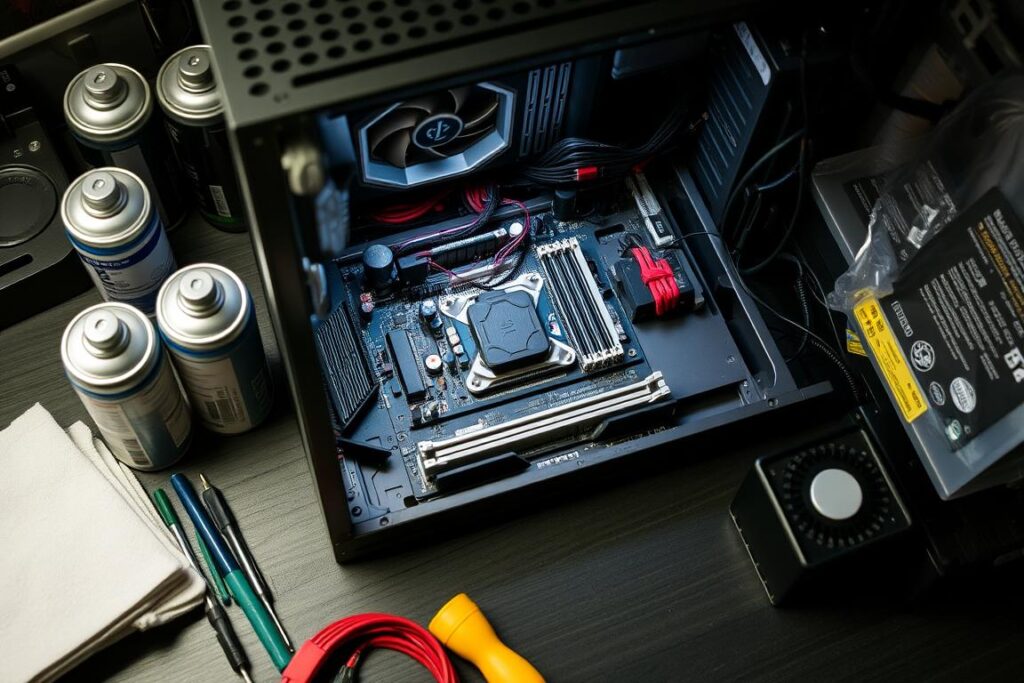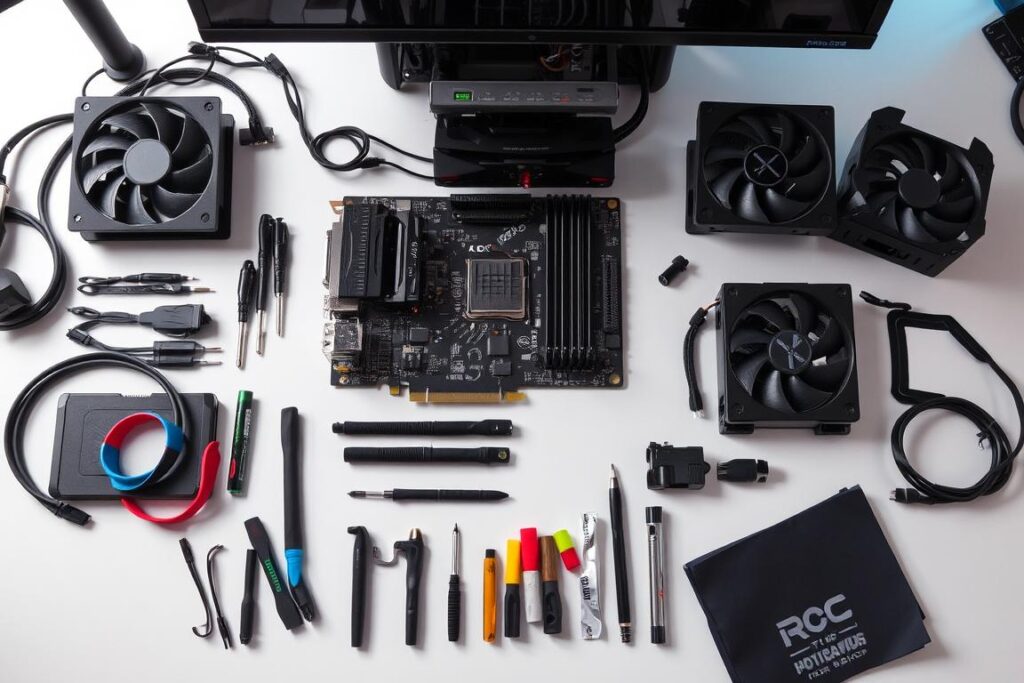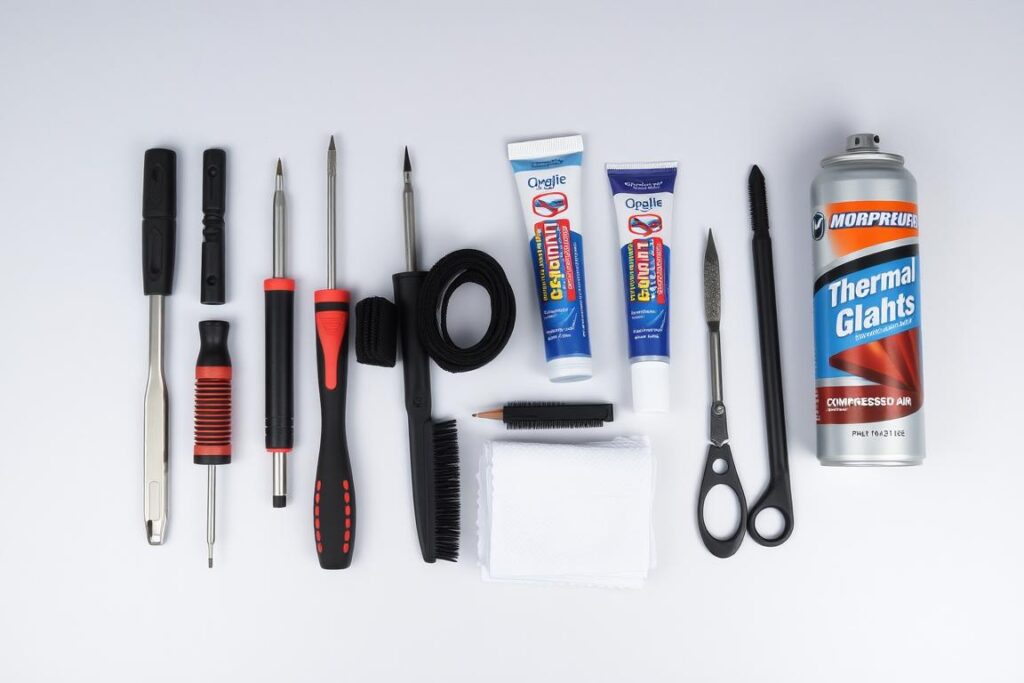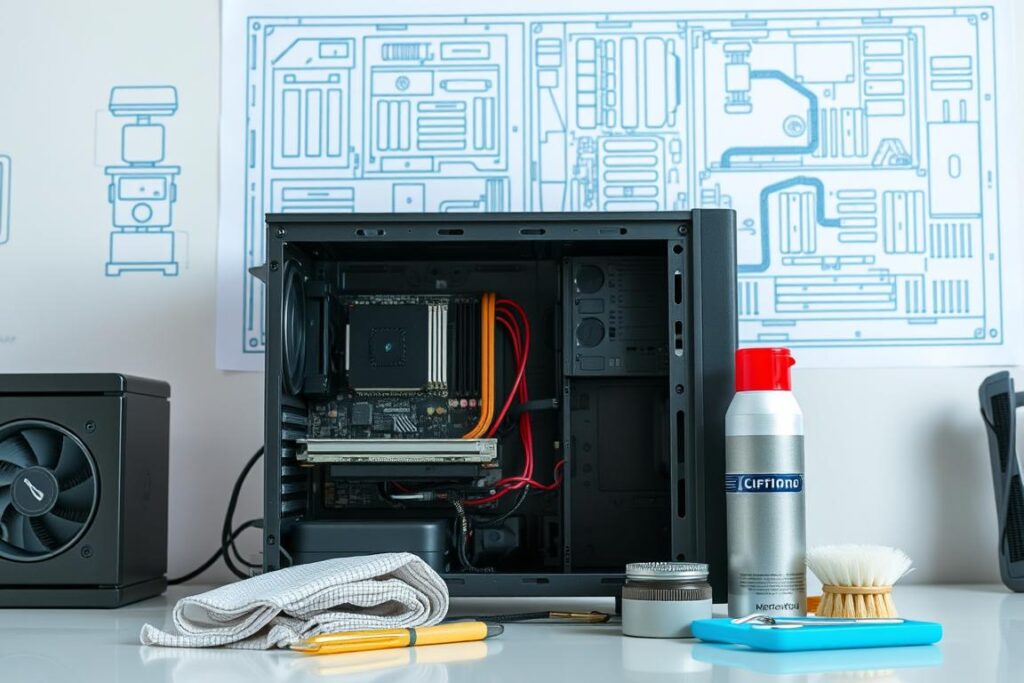What’s a key step to keep your computer running well and lasting longer? It’s all about proper maintenance. This helps avoid hardware failures and saves you money and time. By following some simple tips, you can make sure your computer stays in top shape.
Table of Contents
ToggleKnowing why maintenance is important is the first step. It helps your computer work better and avoids problems. So, what should you do daily to keep your computer’s hardware in good condition?
Key Takeaways
- Regular maintenance is essential to prevent hardware failures
- Proper maintenance can save time and money in the long run
- Essential computer hardware maintenance tips can help keep your computer running smoothly
- Understanding the importance of computer hardware maintenance is crucial
- Implementing a maintenance routine can help prevent common issues
- What is a necessary step in maintaining computer hardware is a crucial question to answer for optimal performance
Understanding Why Computer Hardware Maintenance Matters
Keeping your computer hardware in good shape is key to its long life and performance. If you ignore maintenance, your devices might not work as well, last as long, or even fail. By following a checklist for maintaining your computer hardware, you can avoid these problems and keep your devices running smoothly.
Experts say that regular cleaning, updates, and checks are vital to prevent damage and keep your computer running at its best. This means dusting, updating drivers, and running tests. By doing these things, you can make your devices last longer and save money on repairs.
Some important tasks to add to your routine are:
- Regularly cleaning dust from vents and fans
- Updating drivers and software
- Running diagnostic tests to identify potential issues

By sticking to these best practices and keeping up with regular maintenance, your devices will stay efficient and effective. Always check your maintaining computer hardware checklist to stay on track and keep your devices in top shape.
| Task | Frequency | Importance |
|---|---|---|
| Cleaning dust from vents and fans | Weekly | High |
| Updating drivers and software | Monthly | Medium |
| Running diagnostic tests | Quarterly | Low |
What is a Necessary Step in Maintaining Computer Hardware: A Complete Overview
Keeping your computer hardware in top shape is crucial. Preventative maintenance is the key to this. It means taking steps to keep your hardware running smoothly and efficiently. This approach helps prevent problems before they start and can make your hardware last longer.
Effective maintenance is also vital. It helps spot potential issues early, which reduces the chance of hardware failure. Some key steps include cleaning dust from fans and vents, updating your system and software, and running disk cleanups and defragmentation.
By doing these things, you can make sure your computer hardware is performing at its best. Here are some more tips to keep in mind:
- Check your computer’s temperature regularly to prevent overheating
- Use a surge protector to protect your hardware from power surges
- Back up your data regularly to prevent loss in case of hardware failure
By following these steps and maintaining your hardware effectively, you can extend its life. Remember, keeping your hardware in good shape is an ongoing task. It requires regular attention to ensure your computer runs smoothly and efficiently.

Regular maintenance is essential to prevent hardware failure and ensure your computer is running at its best.
| Maintenance Task | Frequency |
|---|---|
| Clean dust from fans and vents | Every 3-6 months |
| Update operating system and software | As updates become available |
| Run disk cleanups and defragmentation | Every 1-2 months |
Essential Tools and Supplies for Hardware Maintenance
Keeping your computer hardware in top shape requires the right tools and supplies. A well-stocked toolkit is a must. It should include cleaning supplies like compressed air, soft-bristled brushes, and microfiber cloths. These tools help remove dust and debris, preventing overheating and damage.
Diagnostic tools are also key for maintaining your hardware. They include multimeters, cable testers, and thermal imaging cameras. These tools help spot issues early, making maintenance easier. For instance, a multimeter checks power supply voltage and current. A thermal imaging camera finds heat problems in your system.

- Cleaning supplies: compressed air, soft-bristled brushes, microfiber cloths
- Diagnostic tools: multimeters, cable testers, thermal imaging cameras
- Safety equipment: anti-static wrist straps, safety glasses
Having these tools ensures your computer hardware stays in good condition. Always follow safety rules when working with electrical parts. Handle your hardware carefully to avoid damage.
| Tool | Description |
|---|---|
| Cleaning supplies | Used to remove dust and debris from hardware components |
| Diagnostic tools | Used to identify potential issues and test hardware components |
| Safety equipment | Used to protect yourself from electrical shock and other hazards |
Physical Cleaning Procedures for Your Computer
Keeping your computer clean is key to its performance and life span. A clean computer runs better and lasts longer. You’ll need a soft brush, compressed air, and a microfiber cloth to start.
Start by cleaning your keyboard, mouse, and monitor regularly. For the keyboard, shake it upside down to remove debris. Use compressed air to clean between keys, then wipe with a microfiber cloth. For the mouse, brush off dust and dirt from the scroll wheel and buttons.
When cleaning inside your computer, ground yourself to avoid static damage. Use compressed air to clean fans, heat sinks, and other parts. This keeps your computer’s internal parts safe.
Here are some more cleaning tips:
- Use a soft, dry cloth to clean your computer and peripherals
- Avoid liquids and harsh chemicals to prevent damage
- Use compressed air for tight spaces
- Ground yourself to prevent static damage

By following these cleaning steps, you can keep your computer in top shape. Always refer to your computer hardware care best practices and maintaining computer hardware checklist for the best care.
| Component | Cleaning Method |
|---|---|
| Keyboard | Turn upside down, shake out debris, use compressed air, and wipe with microfiber cloth |
| Mouse | Use soft brush to remove dust and dirt from scroll wheel and buttons |
| Monitor | Use soft, dry cloth to clean exterior |
Managing Dust and Airflow in Your System
Keeping your computer in top shape is key to its performance. Managing dust and airflow is a big part of this. Dust can make your computer overheat, leading to slower speeds and a shorter life. Cleaning air vents and fans regularly helps prevent this.
To keep your computer cool, regularly inspect and clean air vents and fans. Use compressed air or a soft brush for this. Also, check for blockages like pet hair that can block airflow and cause overheating. Proper ventilation and dust control are crucial for your system’s health.
Here are some tips to help you manage dust and airflow in your system:
- Regularly clean air vents and fans
- Check for blockages in vents and fans
- Use compressed air or a soft brush to clean hard-to-reach areas
- Keep your computer in a well-ventilated area
By following these tips, you can keep your system running well. Remember, regular maintenance is essential for your computer’s longevity and to avoid expensive fixes.
| Maintenance Task | Frequency |
|---|---|
| Clean air vents and fans | Every 3-6 months |
| Check for blockages | Every 1-2 months |
| Inspect system for dust buildup | Every 6-12 months |
Monitoring and Maintaining System Temperature
Keeping your computer’s temperature in check is key to its health. You should often check your system’s temperature to avoid overheating. This can harm your computer’s parts. Make sure your computer gets enough air by placing it in a well-ventilated spot.
To keep an eye on your system’s temperature, use software like SpeedFan or HWMonitor. These tools give you live temperature readings. They help spot problems early, saving your system from damage. By following these tips, you can make your computer last longer and avoid expensive fixes.
- Keep your computer away from direct sunlight and heat sources
- Use a cooling pad or external fan to improve airflow
- Regularly clean dust from your computer’s vents and fans
By monitoring your system’s temperature and following these tips, your computer will run better. Remember, being proactive is crucial in preventing overheating and other problems.
| Temperature Range | Component | Potential Damage |
|---|---|---|
| 0-50°C | CPU | None |
| 50-70°C | GPU | Reduced performance |
| 70-90°C | RAM | Data corruption |
Hard Drive Maintenance and Data Management
Keeping your computer in top shape is key. Hard drive care and data management are crucial. By following a checklist, you can keep your hard drive running well. This means regular disk cleanup and defragmentation to free up space and boost performance.
It’s also vital to back up your data to avoid loss. You can use external hard drives, cloud storage, or both. Having a good backup plan means your files are safe, even if your hard drive fails.
Disk Cleanup and Defragmentation
- Remove temporary files and system files that are no longer needed
- Use the built-in disk cleanup tool to free up space
- Defragment your hard drive to improve performance
Backup Procedures
Back up your important files and documents. You can use an external hard drive or cloud storage. This keeps your data safe, even if your hard drive fails.
SMART Monitoring
Use SMART monitoring tools to check your hard drive’s health. This helps spot issues early, before they get worse.
Power Supply Care and Protection
When you’re doing computer hardware preventative maintenance, don’t forget the power supply unit (PSU). It’s a key part that needs care to keep your system running well. To protect the PSU, you should avoid overheating, power surges, and other problems.
Start by making sure there’s good airflow around the PSU. Keep it clean from dust and dirt. Clean the vents and fans regularly to keep it working right. Also, using a good surge protector can protect the PSU from power spikes.
Here are some tips for taking care of your power supply:
- Watch the PSU temperature to avoid overheating
- Choose a PSU with high efficiency to make less heat
- Don’t overload the PSU with too many parts
By following these tips, you can make your PSU last longer and work better. Remember, effective computer hardware maintenance means taking care of all parts, like the power supply. This helps prevent problems and keeps your system running well.
Putting power supply care first helps avoid common problems. It makes sure your system keeps running smoothly. It’s a key part of your important computer hardware servicing steps.
Peripheral Device Maintenance
As you keep using your computer, it’s key to remember to take care of your peripheral devices. These include keyboards, mice, monitors, and printers. They are vital for a good computing experience. If you ignore their upkeep, they might not work well and won’t last long.
By following computer hardware maintenance tips, you can keep your devices in top shape. For instance, cleaning your keyboard and mouse often stops dust and dirt from causing harm. Also, make sure to adjust your monitor’s settings to avoid eye strain and get the best picture.
Keyboard and Mouse Care
- Turn your keyboard upside down and gently shake it to remove loose debris
- Use compressed air to clean between keys and crevices
- Wipe down your mouse with a soft cloth and mild soap solution
Monitor Maintenance
Adjust your monitor’s display settings to a comfortable brightness and contrast level. This can help reduce eye strain and improve your overall viewing experience.
Printer Upkeep
Regularly check and replace your printer’s ink or toner cartridges as needed. This will help maintain print quality and prevent damage to the printer.
Common Hardware Issues and Prevention
When you take care of your computer hardware, knowing common problems is key. These issues can slow you down or even crash your system. A maintaining computer hardware checklist keeps you on schedule with upkeep.
Problems like overheating, dust, and power failures are common. To avoid these, clean your vents and fans, watch your system’s temperature, and use a surge protector. These steps can make your hardware last longer and save you money on repairs.
Here are some tips to spot potential problems:
- Keep an eye on your system’s temperature and adjust cooling as needed
- Regularly clean dust from vents and fans
- Use a surge protector to guard against power spikes
By following these tips and staying on top of maintenance, you can avoid common issues. Always stick to computer hardware care best practices. If you’re unsure about maintenance, it’s best to get help from a pro.
| Hardware Component | Common Issues | Preventative Measures |
|---|---|---|
| Power Supply | Overheating, failure | Monitor temperatures, use a surge protector |
| Hard Drive | Failure, data loss | Backup data regularly, monitor disk health |
| Fans and Vents | Dust buildup, overheating | Clean regularly, monitor system temperatures |
Creating Your Annual Maintenance Calendar
To keep your computer hardware in top shape, creating an annual maintenance calendar is key. This calendar will guide you through computer hardware preventative maintenance tasks. These include cleaning dust, checking temperatures, and disk cleanup. By doing these tasks regularly, you’ll keep your computer running well for longer.
A good maintenance calendar should include effective computer hardware maintenance plans. This means setting reminders and prioritizing tasks. For instance, you might want to clean your computer’s air vents every month. You can also plan for important computer hardware servicing steps like part replacements or upgrades.
Here are some tips for making a detailed maintenance calendar:
- Identify the most critical maintenance tasks and schedule them accordingly
- Set reminders for upcoming tasks to ensure you stay on track
- Prioritize tasks based on their level of importance and urgency
By using these tips and making a maintenance calendar, you’ll keep your computer hardware in great condition. Remember to update your calendar often to keep it effective.
| Maintenance Task | Frequency | Importance |
|---|---|---|
| Clean dust from vents and fans | Monthly | High |
| Monitor system temperature | Weekly | Medium |
| Perform disk cleanup and defragmentation | Quarterly | Low |
Conclusion: Implementing Your Hardware Maintenance Strategy
Keeping your computer’s hardware in good shape is crucial. It ensures your device runs smoothly, lasts longer, and saves you money. By following key steps, you can create a maintenance plan that fits your needs. Regular upkeep helps avoid expensive repairs and keeps your computer running without interruptions.
Begin by making a maintenance schedule. It should include tasks like cleaning air vents and checking hard drives. Sticking to this plan helps catch problems early. Also, watch for signs of trouble and fix them quickly.
Putting in the effort to maintain your computer’s hardware is worth it. Your devices will work better, and you’ll avoid the stress and cost of early failures. By taking care of your hardware, you’ll enjoy a reliable and efficient computer system.
FAQ
What is a necessary step in maintaining computer hardware?
Keeping your computer clean is key. Dust can cause overheating and slow performance. Clean both inside and outside your computer regularly.
What are some essential computer hardware maintenance tips?
Here are some important tips:- Back up your data to avoid losing it.- Keep an eye on your computer’s temperature.- Update your software and security patches.- Manage cables and airflow in your computer case.- Clean your keyboard, mouse, and fans to stop dust buildup.
What are the essential steps for computer hardware maintenance?
Here are the main steps:- Clean and dust your computer regularly.- Make sure it has good airflow and cooling.- Back up your data and manage storage.- Update your software and drivers.- Check and replace worn-out parts.- Protect your power supply and other important parts.
What are the best practices for computer hardware care?
Here are some top practices:- Create a maintenance schedule and stick to it.- Use the right cleaning supplies and methods.- Watch your system’s health and fix problems fast.- Keep your hardware safe from dust, moisture, and static.- Store and transport your hardware carefully when not in use.
What are the key steps in maintaining a computer hardware checklist?
A good checklist should include:- Clean your computer’s internal parts and fans.- Check and replace air filters.- Inspect and clean cables and connections.- Update your drivers and software.- Clean up your disk and defragment it.- Back up your data and create system restore points.- Keep an eye on your system’s temperature and cooling.
What are the guidelines for effective computer hardware upkeep?
Effective upkeep includes:- Set up a regular maintenance schedule.- Use the right tools and supplies for cleaning.- Dispose of old or replaced hardware properly.- Ensure good ventilation and airflow in your computer case.- Keep detailed records of maintenance and issues.- Get professional help for complex repairs.
What are the steps for preventative computer hardware maintenance?
Preventive maintenance steps include:- Clean your computer’s internal parts regularly to prevent dust buildup.- Monitor your system’s temperatures and fix overheating issues.- Update your software and security patches to protect against vulnerabilities.- Back up your data regularly to prevent loss.- Inspect and replace worn or damaged components before they fail.- Follow a structured maintenance schedule for consistent upkeep.
What are the important steps in servicing computer hardware?
Important steps in servicing include:- Open your computer case safely and handle components carefully.- Clean and dust your internal components properly.- Check and replace air filters or cooling fans as needed.- Inspect cables and connections for wear or damage.- Update your drivers and software for best performance.- Perform diagnostics to find and fix issues.- Reassemble your computer and test it for full functionality.
